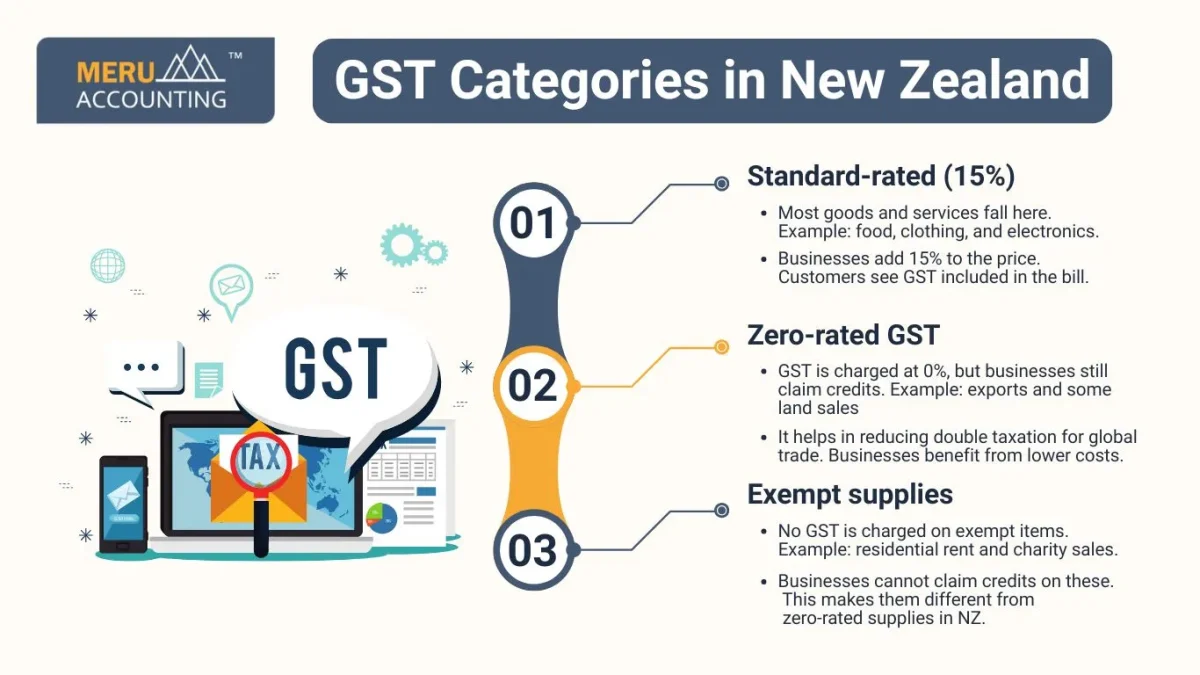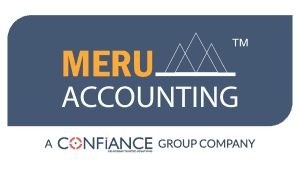Understanding the New Zealand GST Rate
Goods and Services Tax (GST) is an important tax system in New Zealand. Many people want to know what is zero-rated GST and how it is different from exempt GST. Businesses also ask how the New Zealand GST rate works in daily trade.
GST is part of almost every sale and service in the country. It affects both local and global businesses. To manage GST well, businesses must learn about zero-rated supplies in NZ, exempt supplies, and the correct rate. A clear understanding helps to stay compliant and avoid mistakes.
What is GST in New Zealand?
- GST stands for Goods and Services Tax in New Zealand.
It is a type of value-added tax collected on goods and services. - The New Zealand GST rate is 15% on most items.
This means customers pay more, and businesses must pass it to the IRD. - GST applies to sales of goods, services, and imports.
Both large and small businesses need to follow GST rules. - It was first started in 1986 at 10%.
Since then, the rate has changed but remains simple to follow.
Why GST is Important in New Zealand
- GST is a major source of government income.
It funds schools, hospitals, and public projects. - Everyone pays GST when they buy goods or services.
This makes the tax system fair and balanced. - It is easier to manage compared to other complex taxes.
A clear GST system saves time for businesses and the government. - GST also supports trade with other countries.
Zero-rated supplies NZ make global business smoother.
The New Zealand GST Rate
- The current GST rate is 15% on most goods and services.
This rate has been the same since 2010. - When GST was first introduced, the rate was 10%.
It later increased to 12.5%, and now to 15%. - Businesses must add GST to the final price of items.
Customers pay the tax as part of the total cost. - Exceptions exist for exempt and zero-rated items.
These categories reduce the cost for specific cases.
GST Categories in New Zealand
There are three main categories under the GST system:
1. Standard-rated (15%)
- Most goods and services fall here.
Example: food, clothing, and electronics. - Businesses add 15% to the price.
Customers see GST included in the bill.
2. Zero-rated GST
- GST is charged at 0%, but businesses still claim credits.
Example: exports and some land sales. - It helps in reducing double taxation for global trade.
Businesses benefit from lower costs.

3. Exempt supplies
- No GST is charged on exempt items.
Example: residential rent and charity sales. - Businesses cannot claim credits on these.
This makes them different from zero-rated supplies in NZ.
What is Zero-Rated GST?
- Zero-rated GST means GST is applied at 0%.
Businesses can still claim credits for inputs. - It is different from exempt supplies.
Exempt supplies block businesses from claiming credits. - It is mainly used for international trade.
This keeps New Zealand exports competitive abroad. - Many people confuse zero-rated and exempt GST.
Understanding the difference avoids compliance issues.
Zero-Rated Supplies NZ
Some items and services are treated as zero-rated supplies in NZ:
Exports
- Goods shipped outside New Zealand are zero-rated.
Customers overseas do not pay GST. - This helps exporters stay competitive.
It also avoids taxing products twice.
Certain land transactions
- Some land sales between GST-registered parties are zero-rated.
Both buyer and seller must meet IRD rules. - This reduces tax disputes in real estate.
It makes property deals smoother for businesses.
International transport
- Flights and shipping services are often zero-rated.
Example: flights to Australia or overseas shipping. - It lowers the cost of trade and travel.
Businesses save, and customers enjoy lower fares.
Some financial services
- Certain cross-border finance activities are zero-rated.
Example: dealing with foreign currency. - This ensures fair tax treatment in finance.
It keeps New Zealand linked with global markets.
Key Difference: Zero-Rated vs Exempt Supplies
- Zero-rated GST is taxed at 0%.
Input credits are allowed for the business. - Exempt supplies have no GST.
Input credits are not allowed. - Example: exports are zero-rated.
Residential rent is exempt. - Knowing the difference avoids mistakes.
It helps in correct GST return filing.
How GST Works in Business
- Businesses must register if they earn over NZD 60,000.
Registration makes them GST-registered traders. - GST-registered firms must add 15% to taxable items.
They also collect GST from customers. - Input credits can be claimed on business costs.
This reduces the tax load on businesses. - Zero-rated supplies NZ help exporters.
They keep costs down and ensure fair taxes.
GST Registration in New Zealand
- Registration is compulsory above NZD 60,000.
This applies in any 12-month period. - Smaller businesses may still register.
Voluntary registration helps claim input credits. - Once registered, businesses must follow GST rules.
They also need to file regular returns. - Proper records must be kept.
This includes invoices and receipts.
How to Calculate GST
- For a $100 item, GST is $15 at 15%.
Total price = $115. - To remove GST from a price, divide by 1.15.
Example: $115 ÷ 1.15 = $100. - Zero-rated GST adds no tax.
Price stays at $100 with credits still claimable. - This makes exports more affordable.
It benefits both sellers and buyers.
GST Returns and Payments
- Returns are filed monthly, two-monthly, or six-monthly.
The choice depends on business size and turnover. - Businesses report GST collected.
They also claim GST paid on expenses. - If more GST is collected, pay the balance.
If more is claimed, a refund is received. - Filing returns on time is key.
Late filing may bring penalties.
Benefits of GST for Businesses
- Transparent and fair system.
Customers see clear tax charges. - Input credits reduce cost for firms.
Businesses can save money. - Zero-rated GST supports exporters.
It makes global trade smoother. - Being GST-registered builds trust.
Customers prefer registered suppliers.
Common Mistakes in GST Filing
- Not registering at the right time.
This can bring fines from IRD. - Mixing up exempt and zero-rated supplies in NZ.
This leads to wrong returns. - Forgetting to claim input credits.
It increases unnecessary costs. - Wrong GST calculation in invoices.
Customers may lose trust. - Missing deadlines for GST filing.
Penalties and interest can apply.
Tips for Managing GST
- Keep detailed and clear records.
Good records help during audits. - Use accounting software for GST.
It reduces manual errors. - Learn about what is zero-rated GST.
This helps in export and land deals. - Get advice for complex GST cases.
Professional help saves money. - Always file returns on time.
This avoids penalties and stress.
Zero-Rated GST and International Business
- Zero-rated GST makes exports cheaper.
Overseas buyers do not pay GST. - It avoids double taxation for global trade.
This makes NZ products more attractive. - Input credits reduce costs for exporters.
Firms remain competitive in foreign markets. - It supports trade growth.
NZ stays strong in global business.
Zero-Rated GST in Real Estate
- Some land deals are zero-rated.
Both parties must be GST-registered. - The IRD has clear rules for this.
This avoids tax confusion. - Double tax is prevented in real estate.
Buyers and sellers both benefit. - It makes business property sales easier.
Deals are quicker and smoother.
How GST Affects Consumers
- Most goods include GST in the price.
Customers usually see the final amount only. - For exports, no GST is added.
Overseas buyers pay less. - Rent for homes is exempt from GST.
Tenants do not pay extra tax. - Everyday spending is affected by GST.
Everyone contributes to public revenue.
GST for Small Businesses
- Small firms must watch turnover.
Above $60,000 means GST registration. - Input credits help reduce costs.
Even small businesses can benefit. - Zero-rated supplies in NZ matter for exporters.
They allow growth in foreign trade. - Accounting tools make GST simple.
Compliance becomes less stressful.
Importance of Zero-Rated GST for the Economy
- Zero-rated GST boosts exports.
NZ goods stay cheaper overseas. - It attracts more foreign trade.
This grows the economy. - It supports fair competition.
Businesses face less tax pressure. - It creates balance in the tax system.
Everyone pays fairly.
Future of GST in New Zealand
- The current GST rate is stable at 15%.
No major changes are planned. - The system is simple to follow.
It works well for most businesses. - Zero-rated supplies NZ may change with trade.
Future laws may adjust rules. - For now, GST is clear and steady.
Businesses can plan with ease.
The New Zealand GST rate is simple but important for businesses. The standard rate is 15%, but many ask what is zero-rated GST and how it works. Zero-rated supplies in NZ, like exports and land sales, reduce costs and support trade.
The key difference between zero-rated and exempt supplies is input credits. Businesses must learn this to avoid mistakes. Correct GST handling helps with compliance and growth.
At Meru Accounting, we help businesses manage GST with ease. Our team handles GST registration, filing, and compliance. We guide businesses on zero-rated GST, exempt supplies, and the right way to apply the New Zealand GST rate. We also use advanced accounting tools to reduce errors. With our support, your business can stay compliant, save money, and grow without stress.
FAQs
Q1. What is the New Zealand GST rate?
It is 15% on most goods and services in New Zealand.
Q2. What is zero-rated GST?
It means GST is 0% but input credits are allowed.
Q3. What are zero-rated supplies in NZ?
They include exports, some land sales, and international transport.
Q4. What is the difference between zero-rated and exempt GST?
Zero-rated allows input credits, and exempt does not.
Q5. Who needs to register for GST in NZ?
Businesses earning more than NZD 60,000 in 12 months.
Q6. How are GST returns filed?
They are filed monthly, two-monthly, or six-monthly.
Q7. Can small firms benefit from GST registration?
Yes, they can claim credits and build trust.








